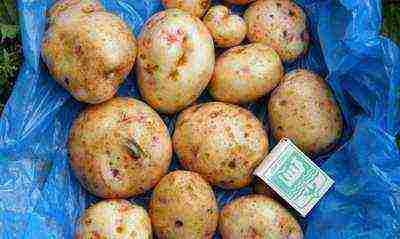Content
- 1 Types of forage grasses
- 2 Family of leguminous herbs
- 3 Family of cereal grasses
- 4 Sedge forage grasses
- 5 Herbs
- 6 Fodder annual grasses
- 7 Perennial forage grasses
- 8 Goat's rue
- 9 Annual ryegrass
- 10 Donnik
- 11 Clover white
- 12 Alfalfa
- 13 Forage grasses
- 14 Silage crops
- 15 Fodder root crops
- 16 Fodder tubers
- 17 Fodder melons and gourds
- 18 Grain crops
- 19 Literature
Annual or perennial forage grasses are valuable agricultural crops that are grown for animal feed. They are distinguished by good yield, nutritional value and are very important and versatile in strengthening the forage base. They are grown for green fodder, silage, haylage, hay, grass meal and as pasture crops.
Fodder grass is a valuable food, since it contains proteins, carbohydrates, fiber, various vitamins and minerals, which are so necessary for the normal development and growth of animals. Its economic value depends on its nutritional value, yield, eaten by livestock, as well as its prevalence in different regions.
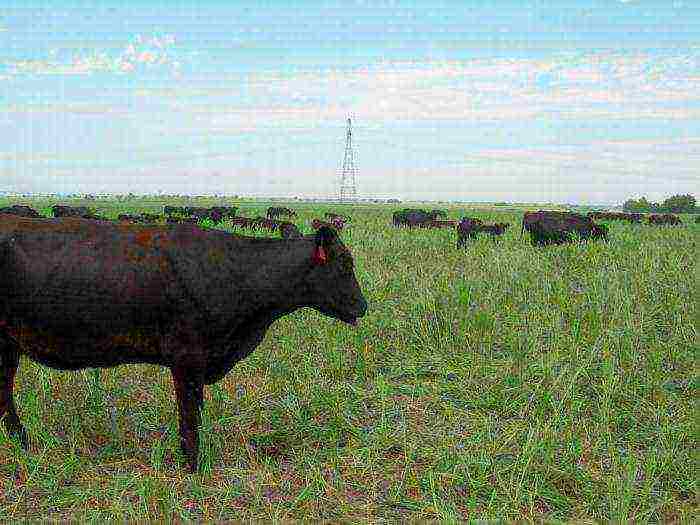
Types of forage grasses
More than 80 species of this crop are cultivated in our country, and about 5000 grow on natural lands.
All forage grasses are divided into 4 groups:
- legumes;
- cereals;
- sedge;
- forbs.
In terms of life span, fodder grass can be annual or perennial.
Family of leguminous herbs
Leguminous forage grass on the forage lands of our country is found in small quantities, but has rather high forage properties: the culture is rich in protein and is well eaten by animals. The most widespread are clover (red, white, pink), horned lily, yellow alfalfa, meadow rank, etc.
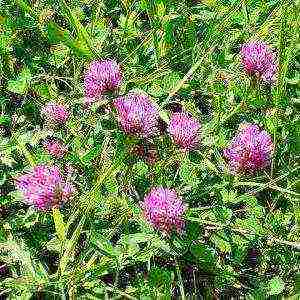
Family of cereal grasses
This group is distributed in almost all zones (except for the desert) and provides most of the yield of pasture fodder or hay (often up to 80-90%). Most cereals have a high nutritional value, especially when young. During the hay harvest during drying, these herbs retain their leaves, which are the most valuable parts. The most widespread are such cereals as feather grass, creeping wheatgrass, pinworm, etc.
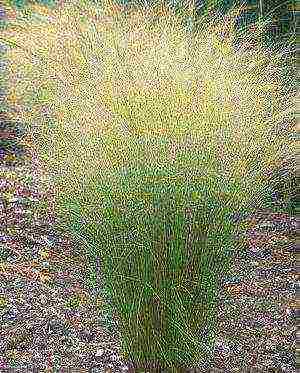
Sedge forage grasses
This group of grasses includes plants from the families of the rump and sedge. These crops are considered to be of little value in terms of fodder and are rather poorly eaten by animals, but in the northern regions of the forest zone they often make up the bulk of hay (sedge, slender sedge, and others). And in the desert and semi-desert, many sedges are a valuable food plant.
Herbs
This group includes all other botanical plant families. Forbs - Meadow forage grasses, which sometimes can account for up to 60-70% of the herbage. Most of them are of great economic importance. Plants from this group are more nutritious than cereals, but most of them are much worse eaten by animals because of the bitter taste, thorniness, pubescence, etc. A small content of forbs (cuffs, dandelion, caraway seeds, etc.) in the herbage (up to 20%) - a desirable impurity, since it helps to improve the mineral composition of the feed and its consumption by livestock.
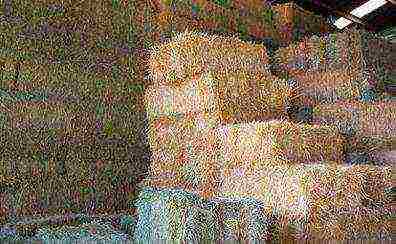
A large number of grasses of this group in the herbage for hay production is extremely undesirable, because:
- it replaces the more valuable legumes and cereals;
- Among the forbs, there are many weeds (field bindweed, yellow thistle, etc.) and poisonous (poisonous buttercup, hellebore, poisonous milestones, aconite, etc.) plants.
Fodder annual grasses
The peculiarity of annual forage grasses is that their development cycle ends within a year, and they die off.They are sown to obtain greens for feeding, for silage, as well as for obtaining a concentrated feed. Annual grasses give high yields of green mass, have a fairly high nutritional value, and have a short growing season.
Due to the fact that the mowing ripeness of plants occurs in about 50-60 days, these crops are indispensable in intermediate crops, in a busy fallow.
Annual grasses are classified into two types:
- legumes;
- bluegrass (cereal).
Annual legume forage crops are sown in early spring. The most valuable plants are spring and winter vetch, rank, fodder lupine, and seradella.
Annual cereal grasses are more thermophilic; they are planted in well-warmed soil after sowing early spring grain crops. The most valuable are: Sudanese grass, mogar, sorghum, annual ryegrass, chumiza, African millet and others.
Perennial forage grasses
Perennial forage grasses are herbaceous sowing plants with a lifespan of more than one year. Raised for livestock feed.
The culture includes more than 50 plant species. They are sown most often in the form of a mixture of grass, which has a positive effect on the quality of forage and soil fertility. They also sow clean crops and create cultivated pastures outside of crop rotations.
In the first year of life, perennial grasses develop rather slowly, become overgrown with weeds and can give a low yield. Therefore, it is recommended to sow them after grain or tilled grain crops, in the soil fertilized with compost or manure.
Perennial forage grasses are also subdivided into:
- Bluegrass (cereal). The most common: timothy grass, awnless fire, pasture ryegrass, wheat grass, high ryegrass, meadow bluegrass, multi-cut ryegrass, rootless wheatgrass, hedgehog, white bent grass, meadow and red fescue, foxtail and others.
- Leguminous herbs: alfalfa, white clover, red clover, pink clover, sainfoin, horned flower.
To create a highly productive herbage, it is necessary to comply with the main agrotechnical methods of crop cultivation.
Goat's rue
Goat's rue is a perennial herb of the legume family. The stem is branchy, erect, usually reaches 1 m in height, and on fertile soils it can grow up to 1.5 m. The root system has a rod type, grows up to 80 cm in depth. Several offspring are formed on the main root. First, they develop horizontally up to 30 cm, then sprout and form new stems.
The leaves of the plant are pinnate petiolate, up to 30 cm long.
Goat's rue is a forage grass with pale purple or blue flowers, similar to bells, which are collected in inflorescence brushes. 3-5 of them can be formed on each stem. Fruiting occurs in September-October. Pods are small in size (2-4 cm in length), dark orange, almost brown, with 3-7 seeds in fruits. The goat's rue is characterized by a rather slow growth, and if it does not grow 20 cm in height by the fall, its harvest is most often transferred to the next year.
Seeds are able to maintain germination quality for up to 8 years.
The goat's rue is a fairly frost-resistant plant that can tolerate well even very harsh winters.
There are 2 known species of this plant: oriental goat's rue (fodder herb) and medicinal.
Annual ryegrass
A very valuable forage plant that provides good quality green fodder and hay. The green mass contains 3.2% protein, 2.3% protein, 8% fiber. It is readily eaten by livestock, in addition, it is a good food for poultry. Hay of annual ryegrass in nutritional properties is not inferior to hay from mogar, Sudanese grass and other cereals. Animals also eat straw well. The annual yield of hay is about 7-8 t / ha, green mass - up to 20-30 t / ha, seeds - 0.5-0.6 t / ha.
Annual ryegrass has a high aftermath; during the growing season it gives 2-3 mows.After the second mowing, the growing aftertaste can be used as pasture fodder until late autumn, since it tolerates small autumn frosts well.
Donnik
This is an unpretentious one-year or two-year legume crop that can grow on the poorest, sandy, stony and clayey soils, as well as in areas where there is no fertile layer. The melilot plant is not afraid of saline and saline soils, but it does not tolerate acidic swampy and floating heavy lands, with a close location of groundwater. The root system is strong and well developed, so this herb is able to produce a good harvest in arid zones, where other forage crops burn out. With a sufficient amount of rain, the yield of green mass can reach up to 7-8 t / ha.
The sweet clover plant is successfully used not only for feed, but also for green fertilization.
Seeds germinate at temperatures from 2 to 50 ° C, seedlings are able to withstand frosts of -6 ... -5 ° C, and some frost-resistant biennial varieties are not afraid of frost up to 40 ° C.
Melilot is a valuable high-protein forage plant, which nutritionally is not inferior to clover, alfalfa and sainfoin. It can often be found in meadows, wastelands, roadsides.
This drought-resistant, frost-resistant and disease- and pest-resistant plant is suitable for greenery, silage and hay production. It can be grown both in grass mixtures and independently.
Clover white
Grows well on sandy loam, loamy, slightly acidic or neutral soils. In the first year, the grass (clover) is able to bloom and produce seeds. Full development begins in the second year of life. In one place it can grow up to 9-10 years.
Grass (clover) is moisture- and sun-loving, frost-resistant. It grows best in regions with a humid cool climate, where there is no drought.
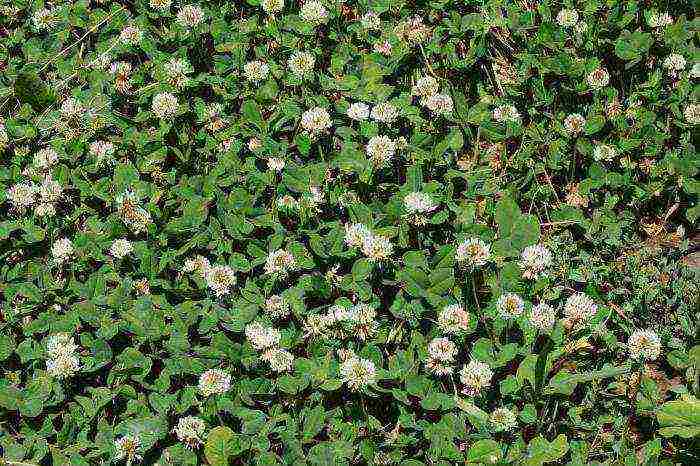
Sowing white clover is an excellent protein-rich forage plant. Trampling by cattle while grazing does not oppress the plant, but, on the contrary, contributes to its better growth. Planting this leguminous crop improves soil fertility. Its inclusion in the composition of a herbal mixture with timothy grass, ryegrass and other plants contributes to an increase in the fodder quality of pasture grass - the content of protein, phosphorus, fat, calcium, potassium increases and the level of fiber decreases. The yield of green mass in meadows is about 60-120 c / ha, hay is about 18-35 c / ha, seeds are 3.0-5.0 c / ha.
Alfalfa
It is a perennial fodder herb of the legume family. It is used both as green forage and for high quality hay production. Alfalfa seeds are also used for medicinal purposes. The culture improves the structure of the soil, as well as enriches the soil with nitrogen, destroys weeds. Differs in high drought resistance and winter hardiness. In the herbage it can keep up to 10 years or even more. After cutting, it grows back slowly.
This grass prefers fodder chernozems, forest-steppe loams, brown and chestnut sierozem soils and other lime-rich soils. Alfalfa grows poorly on swampy and heavy clay soils.
This plant contains a lot of vitamins and protein. It is well digested by herbivores. Alfalfa seeds are sown either in pure form or as a mixture.
Most active assistants for July
-
none
Anisimov Gleb
34 answers
-
none
Komarova Maria
34 answers
-
none
Orlov Pasha
33 answers
-
none
Karpov Zakhar
33 answers
-
none
Zhdanov Petr
33 answers
Anonymous
The world
01 March 21:19
Complain Answer or solution1
Kondratieva Svetlana
Alfalfa is grown for animal feed. The correct answer is "B". Hay is made from it, which is fed to various animals. In addition, alfalfa is used in medicines. Alfalfa has many varieties, some of which are also grown in our country. Lucerne came to us from the Mediterranean countries.
ComplainThanks0
Do you know the answer?
How to write a good answer?
0 / 10000
Good
are you studying?
Help others
schoolchildren!
Need an answer
4th grade
What does low water mean, kruten (not a surname!)
21 May 20:49
Surrounding Mirleningrad compatriot who became famous in the post-war period for his achievements in art
17 May 21:24
The world
4th grade
Write down which cattle and small ruminants are bred in your area. (If possible, name ...
17 May 18:45
The world
4th grade
Russia crafts 18-20 centuries
17 May 08:45
The world
Grade 3
My countryman.
16 May 20:56
Current version of the page so far
not checked
experienced participants and may differ significantly from
versions
Retrieved March 28, 2016; checks require
5 edits
.
Current version of the page so far
not checked
experienced participants and may differ significantly from
versions
Retrieved March 28, 2016; checks require
5 edits
.
Forage crops - agricultural crops grown for animal feed.
Forage crops include perennial and annual forage grasses (for pasture and green summer forage, green mass for hay, haylage, silage, grass meal), silage crops (corn, sunflower, etc.), forage root crops (fodder beets, turnips, rutabagas, carrots), fodder melons (pumpkin, zucchini, watermelon).
Forage grasses
All forage grasses are subdivided into four economic and botanical groups: bluegrass, legumes, sedge and forbs. The first two groups include plants from the corresponding families, the sedge group includes species from the sedge and rump family, and plants of all other botanical families are ranked as forbs.
- Perennial legumes. Meadow clover, creeping clover, hybrid clover, alfalfa, sainfoin, sweet clover, horned clover, eastern goat's rue, medicinal goat's rue, perennial lupine.
- Perennial bluegrass grasses. Timothy grass, awnless rump, meadow fescue, hedgehog, wheatgrass, high ryegrass, multiflorous ryegrass (multi-cut ryegrass), rootless wheatgrass, Siberian hair grass.
- Annual legumes. Sowing vetch (spring), furry vetch (winter), pelushka, seradella, crimson clover.
- Annual bluegrass grasses. Sudanese grass, mogar, annual ryegrass (annual ryegrass).
- Unconventional forage plants. Weirich's highlander, pierced-leaved sylphia, maral root, hard comfrey, oil radish, mallow.
Silage crops
- Corn
- Sunflower
- Kale
- Jerusalem artichoke
- Mustard white
- Winter rape
- Sorghum
Fodder root crops
- Fodder beet
- Sugar beet
- Swede
- Fodder carrots
- Turnips
Fodder tubers
- Fodder potatoes
- Jerusalem artichoke
Fodder melons and gourds
- Fodder watermelon
- Zucchini
- Pumpkin
Grain crops
- Cereals
- Oats
- Barley
- Corn
- Sorghum
- Chumiza
- African millet
- Legumes
- Peas
- Horse beans
- Vika
- Pelushka
- Lupine stern
Literature
- Forage crops // Konda - Kun. - M.: Soviet Encyclopedia, 1973. - (Great Soviet Encyclopedia: / Ch. Ed. A. Prokhorov; 1969-1978, vol. 13).
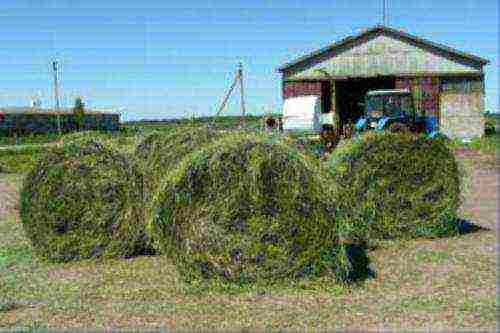
Forage crops are plants grown to feed farm animals. They are cultivated in field and fodder crop rotations, as well as in permanent plots. Now, in the conditions of intensive farming, the cultivation of fodder crops is becoming an independent branch - fodder production.
The most numerous group of forage crops is perennial grasses: legumes (red and pink clover, alfalfa, sainfoin, sweet clover, lyadvenets) and bluegrass, or cereals (timothy grass, meadow fescue, awnless bonfire, hedgehog, wheat grass). Perennial grasses are sown neat and in mixtures, for example, clover with timothy grass, alfalfa with wheatgrass. They are used on the vine as pasture fodder and in the form of green mass for the preparation of hay, haylage, silage, flour, granules and briquettes (see Forage). These foods are rich in protein (especially legumes), vitamins and minerals.In addition, perennial grasses enrich the soil with nitrogen thanks to the nodule bacteria that live on their roots and are able to assimilate nitrogen from the air.
Grasses usually have a fibrous root system, which contributes to the structuring of the soil. Perennial grasses - restorers of soil fertility in crop rotation - increase the content of organic matter, improve its physical properties.
Most types of perennial grasses are moisture-loving plants. With a lack of moisture, they are low-yielding or completely die, therefore, in arid regions, perennial grasses (primarily alfalfa) are grown mainly on irrigated lands.
Of the perennial legumes, the most valuable are red clover and alfalfa. Clover is cultivated mainly in the northern and eastern regions of the country, in regions with a temperate and fairly humid climate, and they get 200-250 centners / ha of green mass (40-50 centners of hay). Alfalfa is sown mainly in the south and west of the country, in the steppe and forest-steppe zones, where it gives high yields. Of the 50 species of alfalfa, blue, or sowing, and yellow, as well as their hybrid forms, are cultivated. Alfalfa produces 2-3 cuttings and more over the summer. The total harvest of green mass reaches 300-400 c / ha, and with irrigation - 700-800 c / ha.
In the steppe zone, sainfoin, a drought-resistant crop, is also cultivated. In terms of fodder qualities, it is not inferior to alfalfa, it ripens earlier and gives hay 50-70 centners per hectare. In our country, common sainfoin, Transcaucasian and sandy sainfoin are cultivated, as well as hybrids of these species. Sandy sainfoin is distinguished by the greatest drought resistance. In the steppe regions, especially on saline soils, sweet clover is grown. Its nutritional value is lower than that of other legumes, but it tolerates soil salinity well.
Of the perennial bluegrass grasses, the most common is timothy grass, the most important crop in the Non-Black Earth Region and the forest-steppe zone. It is grown mainly in mixtures with other herbs, primarily clover.
There is a lot in common in the agricultural technology of perennial grasses. Most often, they are sown under the cover of other crops, mainly grain crops in spring and winter, but sometimes without a cover - for reliable obtaining of good herbage, especially in arid conditions. The seeds of almost all perennial grasses are very small, and therefore their sowing rates are low, usually up to 10-20 kg / ha (for sainfoin - up to 50-90 kg / ha). Almost all grasses, especially legumes, react negatively to increased soil acidity.
To obtain a good herbage, the soils are fertilized. For leguminous grasses, mainly phosphorus-potassium fertilizers are applied, for bluegrass - also high doses of nitrogen. All legumes are cross-pollinated, therefore, in order to increase the productivity of seeds, bees are taken out for crops during flowering. Various chemicals are used to combat pests and diseases, especially in seed plots. Perennial grasses are harvested for feed before flowering.
Annual grasses are sown to provide a green conveyor. They are also used to make hay and other types of feed. From leguminous annual grasses, spring vetch and winter vetch, common peas and pelushka are cultivated. These protein-rich crops are usually sown in mixtures with annual grains - oats, barley. An annual legume crop - seradella - is cultivated on sandy soils in Belarus and Western Ukraine.
In arid regions, annual drought-resistant grasses are grown - Sudanese grass, sorghum, sorghum-Sudan hybrids, mogar, chumiza, as well as vetch and rank in limited sizes. In many regions, winter rye, millet, soybeans, peas are grown as annual grass for green fodder, as well as a new crop - triticale (a hybrid of wheat and rye). Relatively recently, rapeseed (spring and winter) has been grown as a fodder crop for obtaining green mass. In areas with mild winters, intermediate crops of winter rye and winter rape are common, providing the earliest food.After their harvesting, various spring crops are sown.
After harvesting winter or early spring crops, crops of early maturing fodder plants are widely used: white mustard, oil radish, winter and spring rape, lupine, etc.
To obtain a succulent feed, fodder root crops are grown: semi-sugar and fodder beets, carrots, turnips, rutabagas (see Root and tuber crops). They feed cattle and sugar beets. For feed, they use fresh root crops, as well as tops, mainly silage. The main crop of this group of plants is fodder beet. Its root crop is large, well stored. The yield reaches 1000 kg / ha. Turnip is an early maturing root vegetable, but it is less nutritious than beets and does not store well. Fodder potato varieties are grown from tubers for fodder.
Forage crops also include silage crops (corn, sunflowers, fodder cabbage, etc.) and grain fodder crops (oats, barley, corn, etc.),
In our country, fodder crops are grown on large areas. Their total sowing area is 67 million hectares, including the sowing area of perennial grasses - 26 million hectares, annual grasses - 17 million hectares. Fodder root crops and fodder melons - about 2 million hectares, the main grain fodder crops - 45 million hectares, maize for green mass - 17 million hectares.
Forage crops are cultivated in all countries where there is livestock.


